#we live in central europe
Explore tagged Tumblr posts
Text
I need everyone to know that literally less than 2 minutes after @definition-of-awkward and I found out it's been a year since the death of Elizabeth II someone started massive fireworks right outside our building.
The people are celebrating. Happy anniversary!
#royals#we live in central europe#none of our neighbors are Irish nor British as far as we known#happy death of lizzie day everyone#queen elizabeth#elizabeth ii#jess talks
17 notes
·
View notes
Text
i live
#andro talks#sorry ab the lack of activity#there are floods in central europe rn#my city got hit too so we had to prep everything for potential flooding#im safe tho! luckily i live in a spot that turned out to be on high enough elevation and far enough from the river to avoid it#still fucking stressful tho
16 notes
·
View notes
Text
.
#should probably just say that im an American citizen for the amount of doomposting im likely going to do in the next couple days#but for those who thought i was European: ive spent more time in Europe since 2016 than i have in the US#i live in Central Europe as perpetually as i can without EU citizenship#i am a German speaker (and Italian and French)#but legally i do have to be tied to the US and it's deeply unfortunate#my academic work hinges on criticism of nationalism and we live in a scary time for that#also one of my degrees is from a European university#and I've had affiliations as a visiting researcher at two others
10 notes
·
View notes
Text
the more i think abt it the more i think the far right idea of ireland historically being this “pure” island separated from the world around it before its colonisation is just an inversion of british ideas abt ireland which cast it as this backwards place only connected to the world through british influence. and instead of rejecting that framework and investigating the ways in which ancient ireland did play a role in the broader world before colonisation, the irish far right decided that england was completely right about ireland, with the only difference being that they see this mythical isolation as the ideal to be returned to.
edit: i cant believe i have to make this clearer but this post is criticising the irish far right for their hateful and ahistorical beliefs. migration is not colonialism nor is it the cause of irelands problems. it is a morally neutral act.
#bro you are just accepting british paradigms#not to be like we live in a society but.#like do you know how involved ireland was in the transmission and reproduction of texts. do u know abt its tradition of pilgrimage#and the pilgramage sites in ireland that people visited from across the world#(i mean mostly europe and the middle east bc they were christian sites and thats where christians were. but still#but these connections predate christianity#did you know bronze age gold collars from ireland have been found throughout central europe. do you know how amber in ireland. like that in#most of ancient europe. comes from the area around ukraine#i cant emphasise enough how insane the state of the discourse is like. it seems like a lot of people really believe in this past which#never existed#sorry i watched some smarthistory videos abt ancient and medieval irish art and got mad#be quiet b
8 notes
·
View notes
Text
Would anyone be interested in trying Rain world tomorrow? I have some free time and would love to share my current brainrot game with new people >:}
I'll start up a fresh campaign for you and probably won't be on a mic (feeling kinda shy ngl), so no need to fear spoilers from me. I'll follow you around and, if I feel merciful (and you wish me to), I'll take you out of the mouths of various creatures that try to eat you. Maybe some revival as a treat, if I think it would be funny (my cpr skills are BAD also it's a mod so if you want we can pretend it doesn't exist)
So mostly just tossing you to the beasts and wishing you good luck! Everything is negotiable!
(IDEAL: people from Europe, basically no lag
LESS IDEAL, STILL PROBABLY OKAY: Asia and Africa, little lag
WE CAN TRY, LAG MIGHT KICK OUR ASS: Americas and Australia, probably
I HOPE NOBODY READING THIS ACTUALLY LIVES THERE, but we can try and pray it works: Antarctica, bottom of the ocean, the moon I guess)
#LIVING IN CENTRAL EUROPE#could probably play from 10 CEST to uh. 16? yeh#unless something changes#also also!!!#if you want to invite a friend that is also allowed#I can host up to three people#just please have in mind that the more people there is the closer to me they need to live#so my pc doesn't die#we would play over STEAM SHARE#important to mention
3 notes
·
View notes
Text
Landlord decided to raise rent by 40k forints I am so dead
#anyone wanna commission me. or buy my prints on buy-me-a-coffee or idk#but like consistently every month#where do they think we have an extra 40k from?? 😭#'price of living is going up so we had to raise rent'#ma'am do you think MY price of living hasn't been going up. I live in the capital city of the shittiest hellhole in central Europe#can't even move because I just got accepted for master's here#and my partner works here#I applied for some teaching jobs and I'm gonna be freelance translating as much as possible but like#that won't be enough :')#and contrary to popular belief it is very much not possible to work a normal full time day job while doing masters#at least not on this one bc I'll have 10 modules per semester and some of them are 6 classes a week#anyway sorry for the rant session#we've also been having renovations ever since I got back to Budapest which is why I couldn't draw at all#posts from yahar'gul#rambling#personal
1 note
·
View note
Text
Okay but like whenever europe and USA are compared in terms of ruins and artifacts it makes me think "oh but what about Native American artifacts and ruins" and it reminded me of another post I meant to make ages ago but forgot
A while back I went thru the library looking at all the books I could find on the history of Kentucky.
My textbooks and most "reliable" sources when I was a kid said that Kentucky was never actually home to Native Americans, it was just a "hunting ground." This is total bullshit, the living Shawnee whose ancestors lived here know it was bullshit, but how did we get there
A lot of the more recent books I found (from like the 1990's) repeated the "it was only just hunting grounds" thing
But heres the weird thing
When you go back further
The narrative is completely different
so here's the first page of a book published 1872, it's "History of Lexington Kentucky: Its Early Annals and Recent Progress" by George W. Ranck

Let the shock of this first paragraph settle in. Like, damn, this is a whole different picture being painted
now, this Rafinesque fellow he refers to, has been widely referred to as the originator of many claims about Kentucky, and an exaggerator and liar, outright dismissed and scorned by many historians.
Rafinesque is considered to be the source of many claims found in this chapter, and the pompous, flowery language used to state them makes them seem a bit unbelievable. But the claims themselves are not highly unrealistic. These are several of the claims found on pages 2-12 of the book
An artificially built stone well was found by settlers
Earliest settlers plowed up pottery fragments
Settlers dug into an old abandoned lead mine
"Stone sepulchers" were found containing human bones
A large earthen mound 6 feet high was found with pottery and burned wood
A stone mound was found containing human bones
An extensive cave used as a cemetery was found under Lexington, containing embalmed bodies
Flint arrowheads were found
Polished and worked fragments of iron ore were found
Sandstone and limestone tools perforated with holes were found
Rough ingots of copper were found
Stone walls were built defended by entrenchments
It is very important to note that this chapter is insistent that the inhabitants that built these ruins and left these artifacts were NOT Native Americans. Why? Because Native Americans didn't build stuff so advanced! Very circular reasoning.
It was a very common myth that there was some kind of "pre-native-american" race of people that existed in Kentucky. Sometimes this was a way of justifying colonization by saying that well, the Native Americans were just taking over land that wasn't theirs too, so it's okay for us to do it.
It seems to me that when it became clear that Native Americans were the first and only pre-European inhabitants, the stuff about an ancient city under Lexington and all that became dismissed as lies. But are they lies?
I tried to find out, and we know for certain that central Kentucky had many, many burial mounds (some of which I had seen the site of without knowing what I was seeing) and quite a few stone ruins. The builders of the stone ruins are referred to as the "Fort Ancient" people because the earliest settlers incorrectly assumed the stone structures they saw were forts for some defensive or military purpose.
The tools and artifacts being referenced are all known to exist, except I think there aren't any confirmed extant examples of pottery.
The most widely criticized claim in the chapter is the underground cave used as a tomb, but I don't see why—central Kentucky is a limestone karst region and EVERYWHERE has a cave under it. The embalming or mummifying of bodies could have been a flourish or rumor, but the essence of the claim is totally reasonable. Then again, it might not have been, since the area had access to sources of salt. The supposed "lead mine" probably wasn't that specifically, but it's known that Native Americans went inside, explored and used caves.
It was really interesting to me how so many later sources dismissed these claims despite most of them being plausible or just true, and how many of those sources repeated the idea of Native Americans using the land for hunting but not "inhabiting" it. It is two different ways of denying Native Americans were here.
2K notes
·
View notes
Note
Have you ever been to the USA, if you have the chance do cuz we are a big as country and you’d definitely re-think the idea of having one central branch for the usher foundation…
I have, yeah, and I'm well aware of how big it is, but I suspect you might be doing a lot of extrapolation as to what the Usher Foundation is and how it works, since as far as I recall it's only vaguely referenced in a brief mention or two. Like, the Magnus Institute isn't a "central branch" that covers all of Europe, or even the UK - it's an academic institution based in London. So one would assume the Usher Foundation is an Academic institution based somewhere in America (I generally imagine it in the Boston area, or somewhere in that region of New England due to the Poe connection). Also, if academic institutions were like public agencies that had a responsibility to cover geographical areas or populations, I think the more egregious problem would be the Pu Songling Centre in Beijing, as China has five times the population of the USA in roughly the same geographical area.
Also, while I do a lot of research for my stories, especially international ones, and try to get a sense of the specific area I'm writing about, I'm obviously always going to be writing as a Brit and thus with certain British assumptions about how places work. And to be honest, after living my life in an anglophone culture dominated by USAmerican media and constantly seeing those, uh, "interpretations" of the UK, there's a slight feeling of turnabout is fair play.
#You try your best#But a writer is always going to be somewhat trapped#By background#By culture#By language#There no amount of research that makes you not be who you are
1K notes
·
View notes
Text
since we now know that all those "my blog is safe for Jewish people" posts are bullshit, here are some Jewish organizations you can donate to if you actually want to prove you support Jews. put up or shut up
FIGHTING HUNGER
Masbia - Kosher soup kitchens in New York
MAZON - Practices and promotes a multifaceted approach to hunger relief, recognizing the importance of responding to hungry peoples' immediate need for nutrition and sustenance while also working to advance long-term solutions
Tomchei Shabbos - Provides food and other supplies so that poor Jews can celebrate the Sabbath and the Jewish holidays
FINANCIAL AID
Ahavas Yisrael - Providing aid for low-income Jews in Baltimore
Hebrew Free Loan Society - Provides interest-free loans to low-income Jews in New York and more
GLOBAL AID
American Jewish Joint Distribution Committee - Offers aid to Jewish populations in Central and Eastern Europe as well as in the Middle East through a network of social and community assistance programs. In addition, the JDC contributes millions of dollars in disaster relief and development assistance to non-Jewish communities
American Jewish World Service - Fighting poverty and advancing human rights around the world
Hebrew Immigrant Aid Society - Providing aid to immigrants and refugees around the world
Jewish World Watch - Dedicated to fighting genocides around the world
MEDICAL AID
Sharsheret - Support for cancer patients, especially breast cancer
SOCIAL SERVICES
The Aleph Institute - Provides support and supplies for Jews in prison and their families, and helps Jewish convicts reintegrate into society
Bet Tzedek - Free legal services in LA
Bikur Cholim - Providing support including kosher food for Jews who have been hospitalized in the US, Australia, Canada, Brazil, and Israel
Blue Card Fund - Critical aid for holocaust survivors
Chai Lifeline - An org that's very close to my heart. They help families with members with disabilities in Baltimore
Chana - Support network for Jews in Baltimore facing domestic violence, sexual abuse, and elder abuse
Community Alliance for Jewish-Affiliated Cemetaries - Care of abandoned and at-risk Jewish cemetaries
Crown Heights Central Jewish Community Council - Provides services to community residents including assistance to the elderly, housing, employment and job training, youth services, and a food bank
Hands On Tzedakah - Supports essential safety-net programs addressing hunger, poverty, health care and disaster relief, as well as scholarship support to students in need
Hebrew Free Burial Association
Jewish Board of Family and Children's Services - Programs include early childhood and learning, children and adolescent services, mental health outpatient clinics for teenagers, people living with developmental disabilities, adults living with mental illness, domestic violence and preventive services, housing, Jewish community services, counseling, volunteering, and professional and leadership development
Jewish Caring Network - Providing aid for families facing serious illnesses
Jewish Family Service - Food security, housing stability, mental health counseling, aging care, employment support, refugee resettlement, chaplaincy, and disability services
Jewish Relief Agency - Serving low-income families in Philadelphia
Jewish Social Services Agency - Supporting people’s mental health, helping people with disabilities find meaningful jobs, caring for older adults so they can safely age at home, and offering dignity and comfort to hospice patients
Jewish Women's Foundation Metropolitan Chicago - Aiding Jewish women in Chicago
Metropolitan Council on Jewish Poverty - Crisis intervention and family violence services, housing development funds, food programs, career services, and home services
Misaskim - Jewish death and burial services
Our Place - Mentoring troubled Jewish adolescents and to bring awareness of substance abuse to teens and children
Tiferes Golda - Special education for Jewish girls in Baltimore
Yachad - Support for Jews with disabilities
#atlas entry#please add any more you know of an especially add fundraisers for you or people you know#if there are any fundraisers for synagogues please add those as well#jew#jewish#judaism#jumblr#punch nazis
2K notes
·
View notes
Text
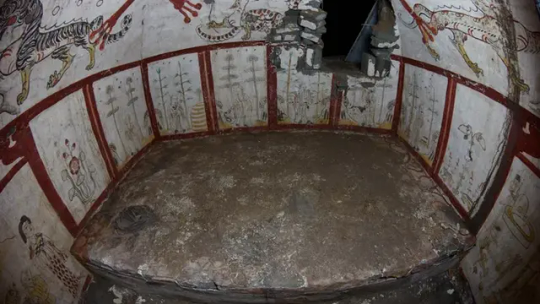
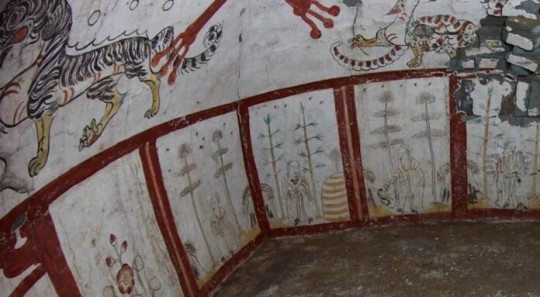
Stunning Tang Dynasty Murals in a Tomb Unearthed in China
A Tang dynasty tomb unearthed in China dates from the 700s, and the murals on its walls give an unprecedented view of daily life at the time.
Archaeologists in northern China have unearthed a centuries-old tomb decorated with stunning murals portraying daily life during the Tang dynasty, which ruled much of central and eastern China from A.D. 618 to 907.
The tomb includes never-before-seen depictions of daily life, including men threshing grain and making noodles.
One of the murals also depicts what appears to be a "Westerner" with blond hair and a beard who probably hailed from Central Asia, Victor Xiong, a professor of history at Western Michigan University who wasn't involved in the discovery, said in an email.
The tomb was discovered in 2018 during roadwork on a hillside on the outskirts of Taiyuan, the capital of China's northern Shanxi province, but archaeologists only reported on the completed excavations last month.
According to an article from China’s government-owned news agency Xinhua, an epitaph in the tomb states it was the burial place of a 63-year-old man who died in 736, as well as his wife.
The tomb consists of a single brick chamber, a door and a corridor. Scenes from life during the Tang dynasty adorn the walls of the tomb, the door, the corridor, and the platform on which the coffin was placed. The domed ceiling of the chamber is painted with what may be a dragon and phoenix.



Tomb guardians
Several figures painted near the door represent the "doorkeepers" or guardians of the tomb; they are wearing yellow robes and some have swords at their waists, according to Xinhua. Other murals portray natural landscapes, as well as men threshing grain, women grinding flour, men making noodles and women fetching water from a well.
They are rendered in the traditional "figure under a tree" style that was popular in the Shanxi region at the time, the South China Morning Post (SCMP) reported. As its name suggests, the style features people carrying out activities underneath beautifully depicted trees.
Many of the figures in the murals look like the same Chinese man and woman, and archaeologists think they may have been the two people buried in the tomb. The woman, in one scene, is dressed in a colorful gown and is leading four horses, alongside a bearded man holding a whip.
Other murals show mountains, trees and camels, and the series of paintings around the coffin may represent the Chinese tomb owner at different stages of his life, Xinhua reported.
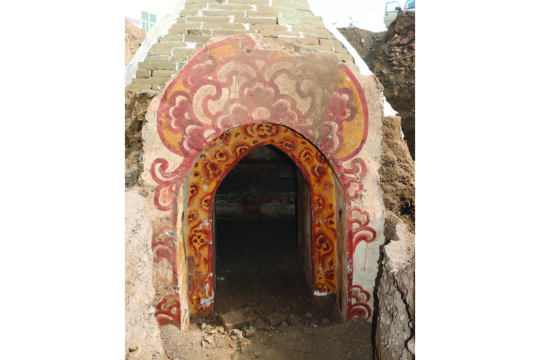

Traditional style
The murals in the tomb appear to be well preserved. "The most familiar theme depicted in these murals is that of human figures under trees — a tradition that harks back to the Han dynasty [206 B.C. to A.D. 220]," Xiong said. Similar murals had been found in China's Xinjiang, Shandong, Shaanxi and Gansu regions.
He noted that the blond "non-Han" man leading camels has distinctive clothing. "Based on his facial features and outfit style, we can identify him as a 'Westerner,' likely a Sogdian from Central Asia," Xiong said. (The Sogdians were a trading people along the Silk Road routes between Asia and Europe at the time, living mainly in what are now Tajikistan and Uzbekistan.
He added that many of the murals gave "never-before-seen" representations of daily chores and labor during the Tang dynasty.
By Tom Metcalfe.
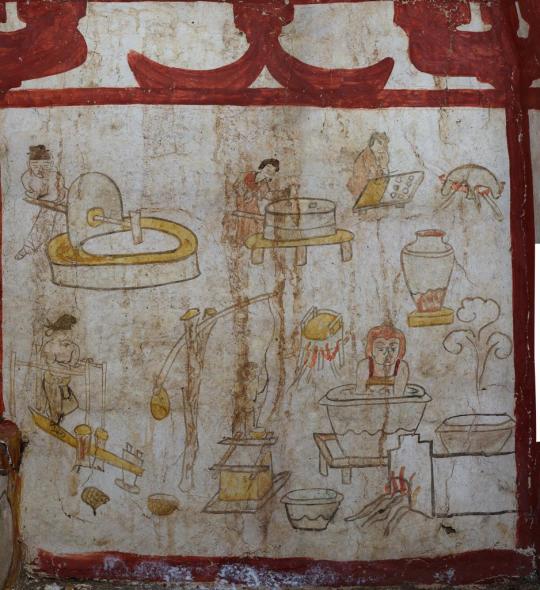


#Stunning Tang Dynasty Murals in a Tomb Unearthed in China#Taiyuan#Shanxi province#China#ancient tomb#ancient grave#ancient murals#ancient artifacts#archeology#archeolgst#history#history news#ancient history#ancient culture#ancient civilizations#ancient china#chinese history#chinese art#ancient art
526 notes
·
View notes
Text
There is a growing body of physiological, anatomical, ethnographic, and archaeological evidence to suggest that not only did women hunt in our evolutionary past, but they may well have been better suited for such an endurance-dependent activity. We are both biological anthropologists. I (co-author Cara) specialize in the physiology of humans who live in extreme conditions, using my research to reconstruct how our ancestors may have adapted to different climates. And I (co-author Sarah) study Neanderthal and early modern human health. I also excavate at their archaeological sites. It’s not uncommon for scientists like us—who attempt to include the contributions of all individuals, regardless of sex and gender, in reconstructions of our evolutionary past—to be accused of rewriting the past to fulfill a politically correct, woke agenda. The actual evidence speaks for itself, though: Gendered labor roles did not exist in the Paleolithic era, which lasted from 3.3 million years ago until 12,000 years ago. The story is written in human bodies, now and in the past.
[...]
Our Neanderthal cousins, a group of humans who lived across Western and Central Eurasia approximately 250,000 to 40,000 years ago, formed small, highly nomadic bands. Fossil evidence shows females and males experienced the same bony traumas across their bodies—a signature of a hard life hunting deer, aurochs, and woolly mammoths. Tooth wear that results from using the front teeth as a third hand, likely in tasks like tanning hides, is equally evident across females and males. This nongendered picture should not be surprising when you imagine small-group living. Everyone needs to contribute to the tasks necessary for group survival—chiefly, producing food and shelter, and raising children. Individual mothers are not solely responsible for their children; in forager communities, the whole group contributes to child care. You might imagine this unified labor strategy then changed in early modern humans, but archaeological and anatomical evidence shows it did not. Upper Paleolithic modern humans leaving Africa and entering Europe and Asia show very few sexed differences in trauma and repetitive motion wear. One difference is more evidence of ���thrower’s elbow” in males than females, though some females shared these pathologies. And this was also the time when people were innovating with hunting technologies like atlatls (spear throwers), fishing hooks and nets, and bow and arrows—alleviating some of the wear and tear hunting would take on their bodies. A recent archaeological experiment found that using atlatls decreased sex differences in the speed of spears thrown by contemporary men and women. Even in death, there are no sexed differences in how Neanderthals or modern humans buried their dead or the goods affiliated with their graves. These indicators of differential gendered social status do not arrive until agriculture, with its stratified economic system and monopolizable resources. All this evidence suggests Paleolithic women and men did not occupy differing roles or social realms.
1K notes
·
View notes
Text
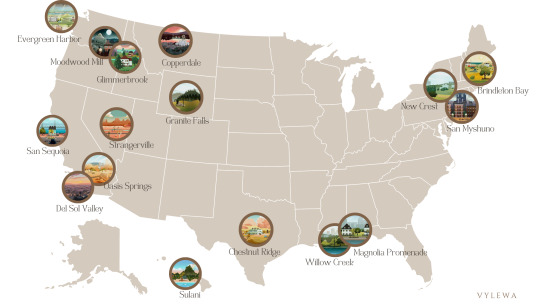

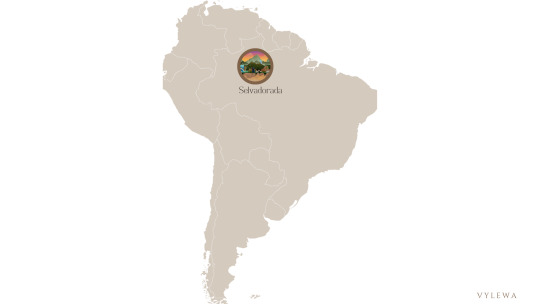
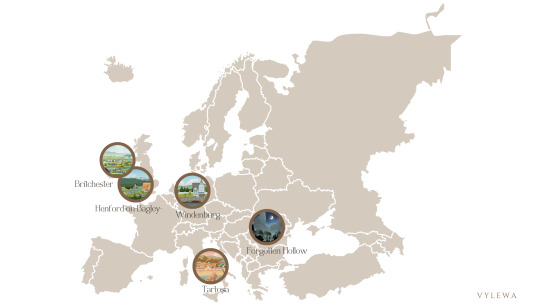
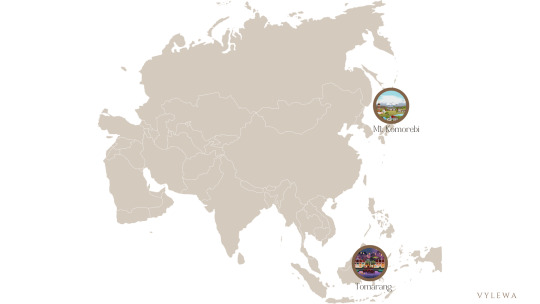
Over the last few weeks, I have been spending my time working on my save file because I'm gearing up to start a Let's Play series on Youtube. As I've been building the stories for the characters in my save file, I started thinking about the Sims universe as a whole and how I want my Sims to travel between worlds. It got me thinking that some worlds feel like they're just a short 4-hour car ride away, while others feel like you'd need a plane to get there.
So, I decided to map out my sims universe. I got a lot of inspiration from different Reddit posts as well as the EA descriptions of each world. This has been so helpful for me as I plan out the buildings I want to place in each world. It has been so helpful with finding inspiration for creating builds. I hope you can find this helpful too.
I'm really happy about my Sims universe turned out. I'd love to hear what you think about it! Are there any worlds you disagree with me on? Also, when are we getting an African world, EA?
North America
New Crest reminds me of suburban New York, mostly because you can still the city skyline from there.
Brindleton Bay reminds me so much of New England.
San Myshuno is quite obviously New York.
Willow Creek gives me a New Orleans vibe.
Magnolia Promenade is somewhere in the south because of the name (magnolias grow in the mostly in Southern United States - Mississippi, Louisiana, Alabama, Florida, Georgia, and South Carolina). I placed it close to Willow Creek for story telling purposes.
Chestnut Ridge gives me a strong Texas vibe.
Del Sol Valley is undoubtedly Los Angeles.
Oasis Springs I think of as Palm Springs with the desert and all, also the Langraabs live there.
San Sequoia I think of as San Francisco mainly because of the Golden Gate Bridge and Bay area, I have all my tech gurus living up there.
Strangerville is straight up Area 51 with all the weird stuff going on there.
Granite Falls gives me a National Park vibe, so I chose my favorite, Yellowstone which is mostly in Wyoming.
Copperdale seems to be in the rocky mountains, I placed it in Montana because of the old mining town description. Butte, Montana used to be a huge mining town.
Moonwood Mill reminds so much of the thick woods in the Pacific West somewhere Washington or Oregon.
Glimmerbrook I imagine is close to Moonwood Mill and the witches and the werewolves are always beefing.
Evergreen Harbor gives me a strong Pacific West port city like Vancouver (I know Vancouver is not in the US, but you get the drift).
Sulani reminds me so much of Hawaii, the beautiful beaches, volcanoes, and mountains and the culture portrayed by Sulanians.
Ciduad Enamorada reminds me so much of Mexico City, Mexico.
South America
Selvadorara gives a strong Amazonian vibe so I placed it in Brazil.
Europe
Britchester because of Britchester uinversity reminds me of Universtiy of Oxford, or University of Cambridge so I placed it in the UK.
Henford-on-Bagley gives off a strong English country vibe so I placed it South Central England.
Windenburg gives off a German vibe because of the style of buildings placed in the world.
Forgotten Hollow I think of as somewhere in Transylvania so I placed it in Romania.
Tartosa is undoubtedly mediterranean so I placed it in Italy.
Asia
Tomarang with the tuk tuks and the tiger sanctuary reminds me of Indonesia.
Mt. Komorebi, my absolute favorte world, is Japan. I can't wait to visit someday.
P.S. Batuu is not included in my sims universe because it is in space, I don't anticipate my sims ever traveling there, but if I ever feel otherwise, I will include it in here.
434 notes
·
View notes
Text
something i think gentiles do not get abt judaism is that it’s not a religion in the modern sense. rabbinic judaism as we know it today exists because of the roman destruction of judea and subsequent genocide and expulsion of a huge number of the judeans living there. prior to that, there were judeans who lived outside judea and still participated in many judean practices and followed many judean laws. there was a conversation happening particularly in the rabbinic movement (which was an incredibly small and fringy movement btw) about how to maintain a cohesive identity and community with members of an ethnic group that had stayed in babylon after being released from slavery or had moved to the italian peninsula or to egypt, and that identity was beginning to form. jewish identity was becoming something we might recognize today.
but prior to the roman expulsion and destruction of the temple, that identity had been centered around the land and the temple for very obvious reasons. ancient israel, judea, it was a place and the people who lived there lived under the same governance with the same culture and the same language. it makes sense they’d be a unique ethnic group. another huge part of the identity they’d formed was opposition to occupying forces, greeks, babylonians, assyrians, and finally the romans. eretz yisrael was constantly under occupation. and rebellion was a unifying force for these people. so when suddenly they have no land to defend, no central temple to look toward, suddenly the rabbis’ outlook on “portable judaism” was pretty much the only option if they wanted to remain a coherent group. they started communicating with each other over thousands of miles and multiple continents, discussing how to maintain their identity while in exile. and that is how judaism formed. it wasn’t a belief system that was spread throughout the world like christianity. it was a group of people whose population and homeland was devastated by a brutal occupying force who were trying to hold on to the only thing they had in strange lands where people weren’t always very welcoming: community. particularly in places like eastern and central europe where jews physically looked so different than the rest of the population, their culture was so different, and europeans reacted very violently to that, holding onto their traditions and immersing themselves in the study of how to stay connected is the reason those communities still exist today. they could have just moved to a new place and assimilated into the populations there and we would not have jews today. the reason we have jews today is because of that communal decision, across continents, to stay connected.
488 notes
·
View notes
Text
Today is Erev Yom Ha'Shoah (Eve of Holocaust Memorial Day) in Israel. It will be observed by Jews outside of Israel, too.

The Hebrew date was chosen to honor the outbreak of the Warsaw Ghetto Uprising. It's also a week before Erev Yom Ha'Zikaron Le'Chalalei Ma'archot Yisrael (Eve of Israel's Memorial Day for its Fallen Soldiers and Terror Victims), which is itself observed a day before Yom Ha'Atzmaut Le'Yisrael (Israel's Independence Day). A lot of people have remarked on the connection between the three dates. On Yom Ha'Atzmaut, we celebrate our independence, which allows us to determine our own fate, and defend ourselves without being dependent on anyone else, right after we remember the price in human life that we have paid and continue to pay for this independence, and a week before we mourn the price we've had to pay for not getting to have self defence during the Holocaust. NEVER FORGET that in one Nazi shooting pit alone (out of almost two thousand) during just 2 days (Erev Yom Kippur and Yom Kippur 1941), more Jewish men, women and kids were slaughtered than in the 77 years since Israel's Independence War was started by the Arabs. This unbreakable connection between the living and the dead, between our joy and our grief, is often addressed with the Hebrew phrase, במותם ציוו לנו את החיים, "With their death, they ordered us to live."

On this Erev Yom Ha'Shoah, I'd like to share with you some data, published on Thursday by Israel's Central Bureau for Statistics (source in Hebrew).
The number of Jews worldwide is 15.7 million, still lower than it was in 1939, before the Holocaust, 85 years ago (that is what a genocide looks like demographically).
7.1 million Jews live in Israel (45% of world Jewry) 6.3 million Jews live in the US (40% of world Jewry)
Here's the data for the top 9 Jewish communities in the world:
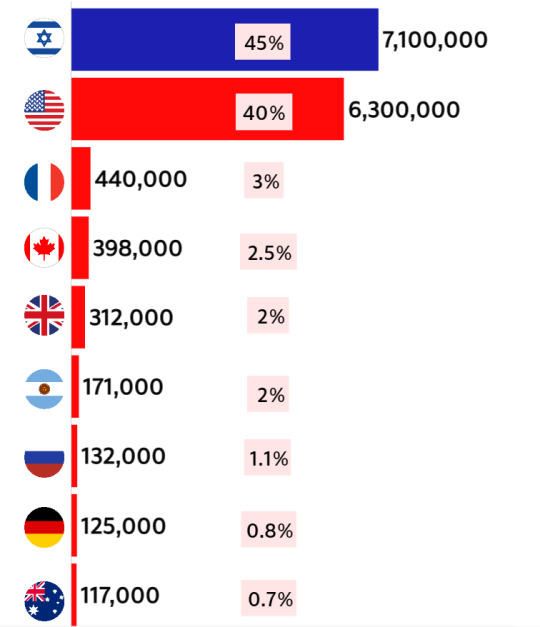
There are about 133,000 Holocaust survivors currently living in Israel. Most (80%) live in big cities in central Israel. Around 1,500 are still evacuated from their homes in northern and southern Israel due to the war (back in January, on International Holocaust Remembrance Day, there was a report about 1,894 survivors who also became internal refugees due to the war. Source in Hebrew). One Holocaust survivor, 86 years old Shlomo Mansour, is still held hostage in Gaza. He survived the Farhud in Iraq.
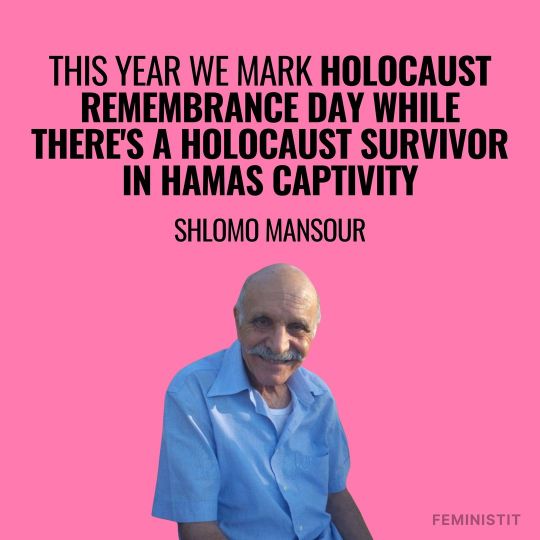
I haven't seen any official number for how many survivors had been slaughtered as a part of Hamas' massacre, despite everyone here being aware that Holocaust survivors had been murdered on Oct 7, such as 91 years old Moshe Ridler. Maybe, as we're still discovering that some people thought to have been kidnapped during the massacre, were actually killed on that day, no one wants to give a "final" number while Shlomo has not yet been returned alive.
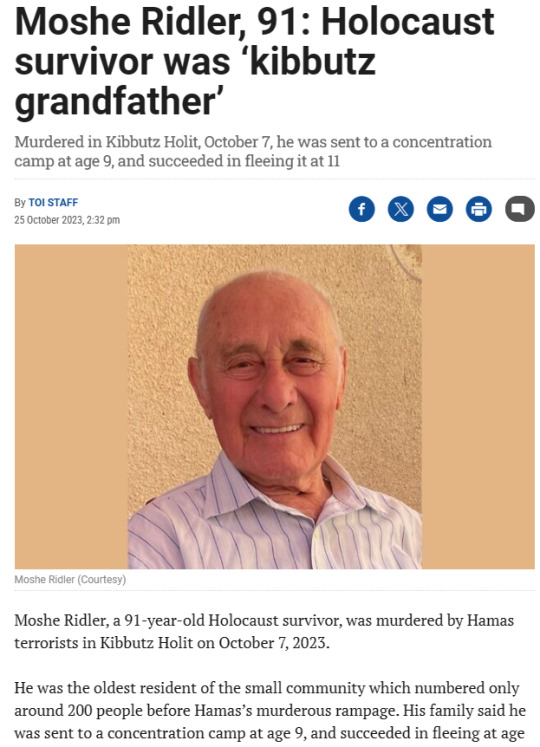
Out of all Israeli Holocaust survivors, 61.1% were born in Europe (35.8% in the countries of the former Soviet Union, 10.8% in Romania, 4.9% in Poland, 2.9% in Bulgaria, 1.5% in Germany and Austria, 1.3% in Hungary, 4.2% in the rest of Europe), 36.6% were born in Asia or Africa (16.5% in Morocco, 10.9% in Iraq, 4% in Tunisia, 2.6% in Libya, 2.1% in Algeria, 0.5% in other Asian and African countries) and 2.3% were born elsewhere.
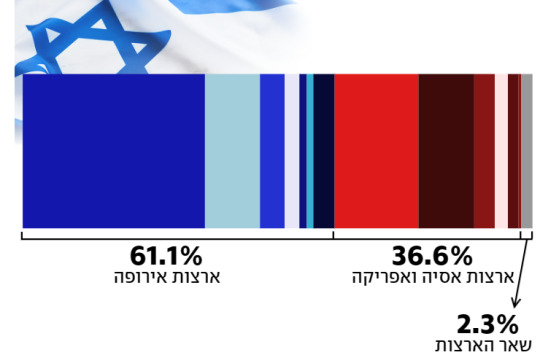
Out of all Holocaust survivors in Israel, 6.2% managed to make it here before the establishment of the state, despite the British Mandate's immigration policy against it (up until May 13, 1948). 30.5% made it to Israel during its very first years (May 14, 1948 until 1951), another 29.8% arrived in the following decades (1952-1989), and 33.5% made Aliyah once the Soviet Union collapsed, and Jewish immigration to the west (which included Israel) was no longer prohibited by the Soviet regimes (1990 on).
The second biggest community of survivors in the world is in the US, the third biggest (but second biggest relative to the size of the population) is in Australia. I heard from many Holocaust survivors who chose to immigrate there that they wanted to get "as physically far away from Europe as possible."
For a few years now, there's been this project in Israel, called Maalim Zikaron, מעלים זיכרון (uploading memory. Here's the project's site in Hebrew. In English it's called Sharing Memories, and here's the English version of the site) where Israeli celebs are asked to meet up with a Holocaust survivor (it's done in Hebrew), and share the survivor's story and the meeting on their social media on Erev Yom Ha'Shoah (which is today). Each year, there's also one non-Israeli Jewish celeb asked to participate (in English. This time around it's Michael Rapaport, he's meeting Aliza, an 81 years old survivor from the Netherlands, who was hidden along with 9 other Jewish babies for two years. He uploaded a preview of his meeting with her here, where he asked her what it means to her to be a Jew, and from what I understand, he will upload more today to the same IG account). This year, there will be an emphasis on Holocaust survivors who also survived Oct 7 (with 6 of the 20 participating survivors having survived Hamas as well). Here's a small bit from an interview with one such survivor, 90 years old Daniel Luz from kibbutz Be'eri:
(for all of my updates and ask replies regarding Israel, click here)
#israel#antisemitism#israeli#israel news#israel under attack#israel under fire#terrorism#anti terrorism#hamas#antisemitic#antisemites#jews#jew#judaism#jumblr#frumblr#jewish#israelunderattack#shoah#holocaust
466 notes
·
View notes
Text
I can't stop thinking how it would be like if Lestat had his interview with Daniel instead of Louis:
"He was the most beautiful man I've ever seen. He also hated himself, which always helps."
"And then he accused me of killing his brother. As if I didn't wait respectful three days after his death to ask Louis back to my bed."
"His mother was hateful. I could smell it. Great fashion sense though. Dark green was in season at the time."
"I turned him in a church. It was...Oh Daniel, the English language fails to capture the picture. Mainly because it's a garbage language."
"He was really freaking out about the baby, like they can't make a new one."
"And then he went into the woods with him. Like a common prostitute."
"So, Daniel, wanna fuck?"
"Naturally Claudia was an ungratefull little brat, who would be nothing without me. But she at least hunted people, which was more than what Louis was doing. Do you have any idea how humiliating it is to live with a vampire who hunts vermin? Like a glorified house cat. Which he also ate. I was disgusted and yet I never judged him for it."
"I record one duet and suddenly I am cheating. I mean I was and he did catch me in bed with her, but he was such an over-reacter Daniel I am telling you."
"She didn't want to finish THE GAME?!!! Who does that?!! What kind of self-absorbed, inffuriating- NO I WILL NOT CALM DOWN!!!! *French cursing*"
"So, I turned her into a vampire. In retrospect it was a waste of time and blood. She lasted like two months. And ugh, the attitude."
"Louis cried, he still loved me I could see it. I could feel it. Claudia just used me as an ink bottle. I had to respect the commitment. Follow through was something Louis always strugled with."
"No, but seriously Daniel, I think we should fuck."
"And he put me in a light oak coffin that opened from the inside. After I specifically requested Rosewood. I know it was Claudia's doing."
"In the end *dramatic pause* I ate the rats. When I was younger I thought I would rather have been dead than to stoop so low, but here we were."
"I miss him Daniel, he was the reason I wanted to survive. Claudia hopefully perished in Central Europe somewhere. With her mismatched skirts."
"I won't turn you, but I can give you a night you won't forget until the end of you pathetic little human existance. You can top I don't care."
#interview with the vampire#iwtv#lestat lioncourt#daniel molloy#louis du pointe du lac#loustat#claudia de pointe du lac#claudia
5K notes
·
View notes
Text
The Words We Use
Jumblr, we really need to reevaluate the words we use to talk about Judaism and Jews and such. Far too long we've been rather lax about these things.
Earlier today I was talking to a friend and she used the term "Jewish Russians" which immediately rubbed me the wrong way. (She's super chill and I've known her most of my life, she meant no harm by it.) I thought about it, and what I realized is that this specific wording, though listing it first, puts the Jewish identity as secondary. By saying "Jewish Russians" the "Jewish" is used as a subcategory of Russains. In reality, this term refers to Jews whose diaspora experience was in Russia. Too long, people have used our diaspora experiences as our central identifiers, and tack on "Jewish" as a classifier within that category.
This is not accurate, not historically, scientifically, or socially.
Socially and historically, Jews were always treated as a category of our own, regardless of where in the diaspora we were located. My parents in the Soviet Union did not have "Russian" or "Moldovan" written in their passports. They had "Jew" written there. I have heard countless tales of hostility and discrimination due to them being Jewish. In Spain, during the Inquisition, Jews who converted were called "conversos", a category of their own despite the forced assimilation. In the Middle East, Jews were treated as second class citizens due to being Jewish, even if they converted. ("Yahood" or "Jew" in Arabic is still commonly used as an insult in ME communities.)
We were never Jewish Russians, Jewish Spaniards, Jewish Moroccans, etc. We were Jews in Russia, Jews in Spain, Jews in Morocco. Even the term itself, "diaspora", (according to Oxford languages: "the dispersion or spread of a people from their original homeland") indicates a separate origin.
Genetic studies confirm this, showing that Jews in whatever region they spent exile in would still be more genetically similar to Jews in other regions than goyim in the regions they lived in.
My parents are not Jews from Eastern Europe. They are Jews whose diaspora experience was in Eastern Europe. Even saying we're "from" there, gives people the wrong idea.
Next up, more commonly discussed, is calling some Jews "white". No Jew is "white" in any sense of that word. White-passing, yes. White, no. In society, being white is more social than physical. It's based on how you're treated, what your status in society is, based on ethnicity/race.
"Jewish" is an ethnicity, and has been considered a race historically. No Jew is white. Many have features commonly associated with being Jewish, and their treatment will of course vary from the experiences of more white-passing Jews. But even the most white-passing Jew will have to deal with antisemitism in some way.
We need to stop saying "white Jews" and replace it with "white-passing". Denormalize language that positions Jewishness as only religion.
To combine the previous concepts:
Replace "Jewish *blank*" with "*blank* Jews" when talking about countries of recent origin.
Instead of "Jews from *blank*" use something along the lines of "Jews with diaspora experiences in *blank*".
Instead of "white Jews" use "white-passing Jews".
It is so incredibly important that we use language that accurately reflects our identity as Jews, instead of settling on commonly used language that is inaccurate.
And finally, could we please normalize using "Judeans" instead of "Jews"? It's not as important as the other switches but it is so important to highlight our origins in Judea, and it could be a useful way to bring that fact into the spotlight.
Fellow Jews/Judeans, feel absolutely free to reblog with other language switches you'd want to see in our communities, whether in the same theme or not.
Goyim, please refrain from speaking over us on this, but I'd appreciate you amplifying this if you'd like to!
251 notes
·
View notes